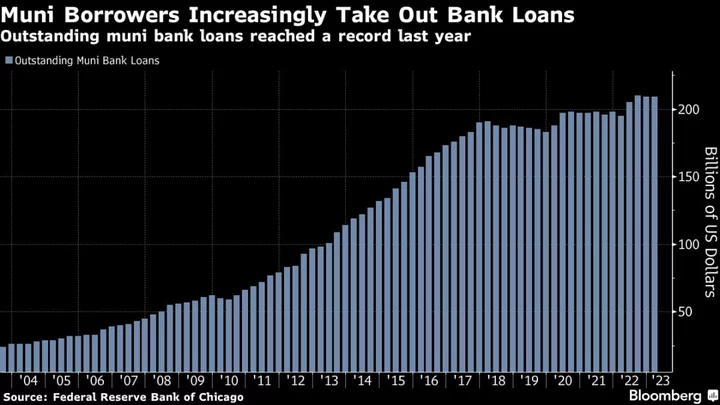State and local governments are increasingly turning to banks for capital during financial distress and market volatility.
Outstanding municipal bank loans are just $1 billion away from the record $210 billion reached in 2022, according to a Federal Reserve Bank of Chicago working paper. Rather than issuing debt in the public markets to raise money, US governments are going directly to banks as they did during the Great Recession and more recently, the Covid-19 pandemic.
Private lending comes in handy during periods of big change, said Chicago Fed senior economist Ivan Ivanov, one of the authors of the working paper, in an interview. He added that bank loans give borrowers a chance to adjust terms when credit quality changes and can provide local governments money when budget strains arise from pension and health care costs.
“The major take away is that bank loans give borrowers in this case local governments such as cities, counties, school districts and special districts substantial financial flexibility that they are not able to find in the municipal bond market,” said Ivanov, who declined to comment on the future trajectory of muni bank loans.
As governments face further fiscal pressure, access to capital in a way the $4 trillion muni bond market can’t provide could be appealing. Revenue growth is expected to slow after billions in stimulus aid runs out, tax collections decline and costs rise from the Federal Reserve’s historic interest-rate hiking campaign.
Bank debt is “most attractive” to government borrowers that have stable revenue but are facing shortfalls, higher borrowing costs, reduction in bond market access and credit downgrades, according to the report. During the pandemic, for instance, Chicago tapped $450 million from a revolving line of credit from JPMorgan Chase & Co. to cover revenue losses in 2020.
Read more: Chicago to Repay $225M Balance on JPMorgan Loan on Nov. 22
The Chicago Fed research shows that higher credit risk translates to more bank loans as governments with agency ratings of AA, A, and BBB, or lower, are as much as 9 percentage points more likely to take one than AAA-rated issuers.
Muni borrowers are following corporations in fueling the broader global growth in private credit. Along with bank loans, state and local governments are also using more private placements, in which an agent sells securities directly to investors to raise capital rather than selling them in the market, especially for riskier projects. But while these tools provide options, they aren’t a panacea for fiscal pressures.
Bank loans in particular “may be costlier than municipal bonds for some governments” due to fees, costs to renegotiate contracts or covenants, according to the report.
However, more environmental, social and governance rules and financial data transparency and disclosures regulations could push governments to bank loans and private placements, said David Erdman, a managing director at Baker Tilly Municipal Advisors.
Private lending “is not a win-win situation,” for municipalities, Erdman said.

